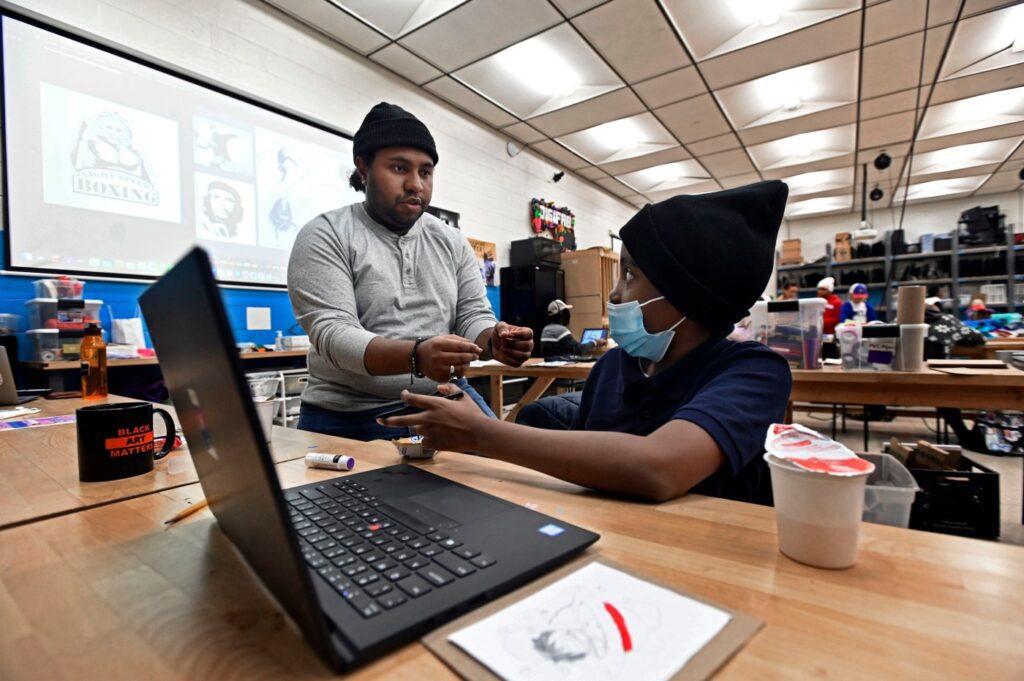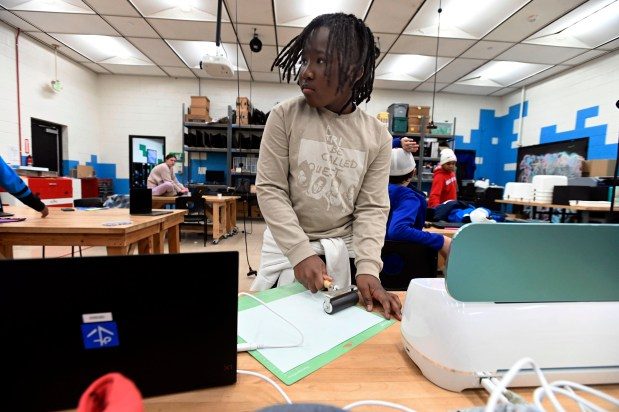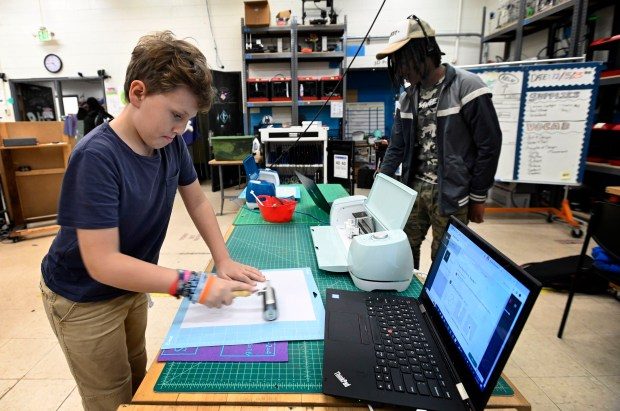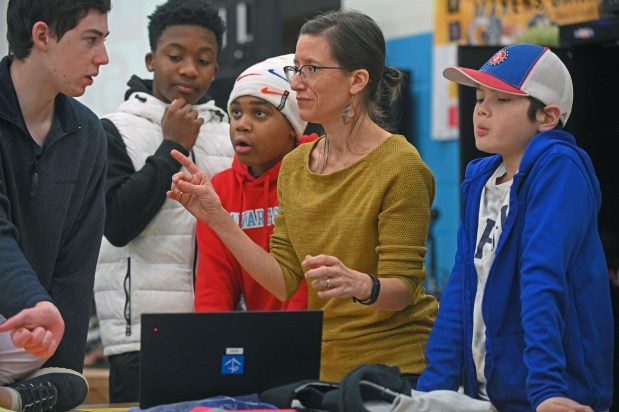State and local officials try to bridge Baltimore’s internet and digital access gaps
- January 9, 2024

Baltimore City students are discovering potential new career paths in classes that cover topics such as coding and graphic design at a local tech center.
“I wanted to learn more about technology because this will help when I get older,” said Zaire Blackwell, a 12-year-old student at the Digital Harbor Foundation. “Some of the stuff I want to do has a lot to do with technology.”
As Maryland continues to create programs to fill gaps in internet access throughout the state, Gov. Wes Moore and local organizations have started to focus on ensuring residents have digital literacy skills, technical support and affordable broadband, especially in areas like Baltimore City.
Around 19% of Baltimore’s population lives in poverty, compared with about 9% statewide, according to the U.S. census 2022. For many lower-income households and communities of color, the lack of internet or a computer is increasing gaps in educational attainment and financial security, according to a May 2020 report from the Abell Foundation.
Outside school, children have found a place where they can access the internet and cultivate their digital skills: the Digital Harbor Foundation.
The foundation transformed the former South Baltimore Recreation Center in January 2013 into a tech center that provides youth with access to tech-powered learning opportunities and supports educators through training and content.

“This has helped me find something to do after school,” Blackwell said. “A lot of stuff I want to do when I get older I have to use. Sometimes we did stuff like this at school, but mainly, it is easier to do it here.”
At the tech center, the foundation allows youths to register for classes that will build digital skills such as coding, design principles and engineering principles. Registration is free, and computers are provided for projects.
The foundation has three different classes with typically 20 kids in each class. Each class covers similar topics but is directed toward a separate age group. Classes take place in two classrooms at the same time during the after-school hours.
“I couldn’t really do a lot of this stuff at home because the design program costs a lot of money,” said Albie Funk, a 9-year-old student at the Digital Harbor Foundation.
Educators have honed their skills with the Digital Harbor Foundation through Maryland Continuing Professional Development-eligible courses such as Coding and the Curriculum: Intro to Scratch for Educators and Computer Science for Middle School.
The state has attempted to address Baltimore’s needs through the Maryland Emergency Education Relief Grant, which provides $2,553,282 for 12 K-12 institutions to close the gap for students who lack internet access or the devices they need to connect to classrooms.
“Bridging the homework gap is critical to ensure that students across Maryland school communities, whether rural, urban or suburban, can access the digital tools for academic success,” Clarence Crawford, Maryland State Board of Education president, said in an email to The Baltimore Sun. “High-speed internet service, both inside and outside of classrooms, helps students, families, schools and communities to meet the demands of our global society.”

The Maryland Office of Statewide Broadband has invested more than $300 million into broadband infrastructure and programs since it was created in 2017.
Those efforts provide high-speed internet access to an estimated 52,000 previously unserved homes and businesses statewide.
The office has been able to reduce the number of unserved households and businesses from around 5% to 1% over the past five years, according to the Maryland Department of Housing and Community Development.
For the 1% unserved, the state is bringing in two programs.
Home Stretch for Public Housing has received $45 million, which will provide funding directly to local jurisdictions that own public housing units to install broadband facilities, wireless access points and additional eligible broadband elements.
Home Stretch for Difficult to Serve Properties has received more than $24 million, which will fund broadband projects focused on bringing high-speed internet access to remote properties that have a hard time obtaining service due to distance from broadband infrastructure or other geographic issues that may discourage an internet service provider from delivering service.
The Maryland Office of Statewide Broadband was taking applications through Dec. 22 for the Home Stretch for Public Housing program.
For digital equity, Moore is awarding more than 133,000 laptops to 27 local governments and their partners for distribution to underserved households in communities across Maryland.
The state continues the push for high-speed internet access by using a $27.2 million investment through the Office of Statewide Broadband’s Connected Devices Program, in which 27 jurisdictions have been provided internet-enabled devices to give to eligible households. There was also a stipend of $6 per device for distribution.
Some jurisdictions requested up to 30,000 devices in their applications on top of the funding to help pay for the distribution of devices. The state awarded all 27 jurisdictions that applied between two rounds in February and October 2023.
“These devices are a gateway for Marylanders to be able to apply for jobs, complete schoolwork and connect with vital community resources,” Moore said in a Nov.17 news release. “In partnership with local governments and community organizations, we are connecting underserved households with the tools they need to succeed and to connect with more opportunities.”

The department has partnered with HP and Daly Computers to supply nearly 135,000 Chromebooks across the state. The department also partnered with the University of Maryland’s TechExtension, which provides free, one-on-one tech support through its digital navigator program to any Marylander who needs assistance with a device.
Along with the state contribution, the Digital Harbor Foundation started Project Waves in 2018 with help from public and private partners to connect more than 300 households to free, high-speed home internet service.
“For those that we serve, it makes a big difference to not have to pay for internet,” said Andrew Coy, president at Digital Harbor Foundation. “For many people, they haven’t had internet before for a variety of reasons. But, if you are not online in 2023, it’s multiple barriers like the cost of internet or background of digital skills to be able to use the device.”
Most Viewed
More
- AandE
- Allegheny
- Books
- Celebrities
- Celebrity News
- Editors Picks
- Health Now
- Local
- MLB
- Monroeville
- More A and E
- Most Recent Obituaries
- Movies TV
- Murrysville
- Music
- News
- News & Advice
- NFL
- NHL
- Norwin
- Penn Hills
- Pirates
- Pittsburgh
- Plum
- Politics Election
- Sports
- Steelers
- Theater Arts
- Top Stories
- Tribune Review Obituaries
- US-World
- Valley News Dispatch
- Westmoreland
- World